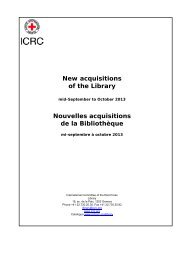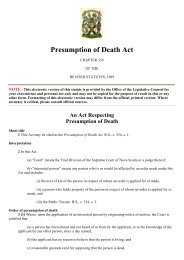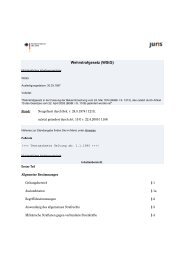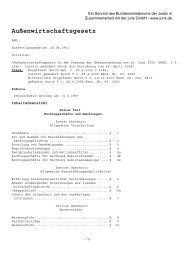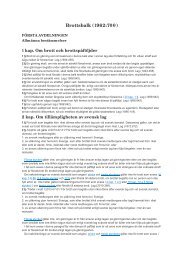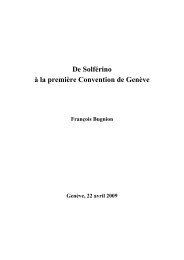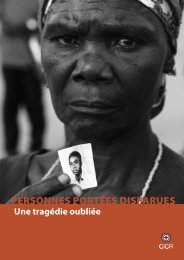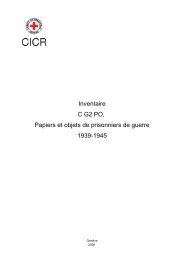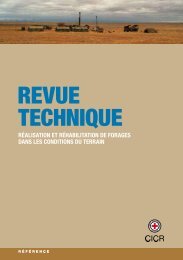- Page 1 and 2: UN DROIT DANS LA GUERRE ? Cas, docu
- Page 3 and 4: 2 Bibliographie générale 1952, 94
- Page 5 and 6: 4 Bibliographie générale Law Appl
- Page 7 and 8: 2 Notion, objectif et problématiqu
- Page 9 and 10: 4 Notion, objectif et problématiqu
- Page 11 and 12: 6 Notion, objectif et problématiqu
- Page 13 and 14: 8 Notion, objectif et problématiqu
- Page 15 and 16: 10 Notion, objectif et problématiq
- Page 17 and 18: 2 Le droit international humanitair
- Page 19 and 20: 4 Le droit international humanitair
- Page 21 and 22: 6 Le droit international humanitair
- Page 23 and 24: 8 Le droit international humanitair
- Page 25 and 26: 10 Le droit international humanitai
- Page 27 and 28: 12 Le droit international humanitai
- Page 29 and 30: 14 Le droit international humanitai
- Page 31 and 32: 16 Le droit international humanitai
- Page 33 and 34: 18 Le droit international humanitai
- Page 35 and 36: 20 Le droit international humanitai
- Page 37 and 38: 22 Le droit international humanitai
- Page 39 and 40: 24 Le droit international humanitai
- Page 41 and 42: 26 Le droit international humanitai
- Page 43 and 44: 28 Le droit international humanitai
- Page 45 and 46: 30 Le droit international humanitai
- Page 47: 32 Le droit international humanitai
- Page 51 and 52: 36 Le droit international humanitai
- Page 53 and 54: 38 Le droit international humanitai
- Page 55 and 56: 40 Le droit international humanitai
- Page 57 and 58: 42 Le droit international humanitai
- Page 59 and 60: 44 Le droit international humanitai
- Page 61 and 62: 46 Le droit international humanitai
- Page 63 and 64: Partie I - Chapitre 3 1 Chapitre 3
- Page 65 and 66: Partie I - Chapitre 3 3 Par celle-c
- Page 67 and 68: Partie I - Chapitre 3 5 Journal of
- Page 69 and 70: Partie I - Chapitre 3 7 monastères
- Page 71 and 72: Partie I - Chapitre 3 9 - Règles s
- Page 73 and 74: Partie I - Chapitre 3 11 2002 Entr
- Page 75 and 76: 2 Les sources du droit internationa
- Page 77 and 78: 4 Les sources du droit internationa
- Page 79 and 80: 6 Les sources du droit internationa
- Page 81 and 82: 8 Les sources du droit internationa
- Page 83 and 84: 10 Les sources du droit internation
- Page 85 and 86: 12 Les sources du droit internation
- Page 87 and 88: 14 Les sources du droit internation
- Page 89 and 90: 16 Les sources du droit internation
- Page 91 and 92: Partie I - Chapitre 5 1 Chapitre 5
- Page 93 and 94: Partie I - Chapitre 5 3 DÉFINITION
- Page 95 and 96: Partie I - Chapitre 5 5 V. C OMPLÉ
- Page 97 and 98: Partie I - Chapitre 5 7 GROSS Micha
- Page 99 and 100:
Partie I - Chapitre 5 9 Carolina Jo
- Page 101 and 102:
Partie I - Chapitre 5 11 b) une foi
- Page 103 and 104:
Partie I - Chapitre 5 13 En tant qu
- Page 105 and 106:
Partie I - Chapitre 5 15 GRÜNEWALD
- Page 107 and 108:
Partie I - Chapitre 6 1 Chapitre 6
- Page 109 and 110:
Partie I - Chapitre 6 3 I. QUI EST
- Page 111 and 112:
Partie I - Chapitre 6 5 Cas n° 81
- Page 113 and 114:
Partie I - Chapitre 6 7 SUGGESTIONS
- Page 115 and 116:
Partie I - Chapitre 6 9 Jurist, vol
- Page 117 and 118:
Partie I - Chapitre 6 11 1. La pré
- Page 119 and 120:
Partie I - Chapitre 6 13 récents :
- Page 121 and 122:
Partie I - Chapitre 6 15 f) règles
- Page 123 and 124:
Partie I - Chapitre 6 17 a) les car
- Page 125 and 126:
Partie I - Chapitre 6 19 L. B., «
- Page 127 and 128:
Partie I - Chapitre 7 1 Chapitre 7
- Page 129 and 130:
Partie I - Chapitre 7 3 Cas n° 95
- Page 131 and 132:
Partie I - Chapitre 7 5 e) le perso
- Page 133 and 134:
Partie I - Chapitre 7 7 d) respecte
- Page 135 and 136:
Partie I - Chapitre 7 9 VI. L’EMB
- Page 137 and 138:
Partie I - Chapitre 7 11 pp. 424-43
- Page 139 and 140:
Partie I - Chapitre 7 13 Cas n° 2
- Page 141 and 142:
Partie I - Chapitre 7 15 SUGGESTION
- Page 143 and 144:
Partie I - Chapitre 8 1 Chapitre 8
- Page 145 and 146:
Partie I - Chapitre 8 3 Law, 1989,
- Page 147 and 148:
Partie I - Chapitre 8 5 disposant q
- Page 149 and 150:
Partie I - Chapitre 8 7 Judith & JA
- Page 151 and 152:
Partie I - Chapitre 8 9 dd) raisons
- Page 153 and 154:
Partie I - Chapitre 8 11 a) toutes
- Page 155 and 156:
Partie I - Chapitre 8 13 aa) le res
- Page 157 and 158:
Partie I - Chapitre 8 15 war victim
- Page 159 and 160:
Partie I - Chapitre 8 17 dd) le tra
- Page 161 and 162:
Partie I - Chapitre 8 19 3. le trai
- Page 163 and 164:
Partie I - Chapitre 8 21 dont ils s
- Page 165 and 166:
Partie I - Chapitre 8 23 a) protect
- Page 167 and 168:
Partie I - Chapitre 8 25 bb) pour l
- Page 169 and 170:
Partie I - Chapitre 8 27 Sur cette
- Page 171 and 172:
Partie I - Chapitre 8 29 University
- Page 173 and 174:
Partie I - Chapitre 8 31 Humanitari
- Page 175 and 176:
Partie I - Chapitre 8 33 Cas n° 1
- Page 177 and 178:
Partie I - Chapitre 8 35 a) les res
- Page 179 and 180:
Partie I - Chapitre 8 37 b) excepti
- Page 181 and 182:
Partie I - Chapitre 8 39 SUGGESTION
- Page 183 and 184:
Partie I - Chapitre 8 41 b) interdi
- Page 185 and 186:
Partie I - Chapitre 8 43 c) la dest
- Page 187 and 188:
Partie I - Chapitre 8 45 bb) obliga
- Page 189 and 190:
Partie I - Chapitre 8 47 militaire
- Page 191 and 192:
2 La conduite des hostilités II.
- Page 193 and 194:
4 La conduite des hostilités c) a
- Page 195 and 196:
6 La conduite des hostilités Deux
- Page 197 and 198:
8 La conduite des hostilités 5. D
- Page 199 and 200:
10 La conduite des hostilités Ca
- Page 201 and 202:
12 La conduite des hostilités a)
- Page 203 and 204:
14 La conduite des hostilités bb)
- Page 205 and 206:
16 La conduite des hostilités pp.
- Page 207 and 208:
18 La conduite des hostilités du
- Page 209 and 210:
20 La conduite des hostilités and
- Page 211 and 212:
22 La conduite des hostilités bou
- Page 213 and 214:
24 La conduite des hostilités civ
- Page 215 and 216:
26 La conduite des hostilités SUG
- Page 217 and 218:
28 La conduite des hostilités Pac
- Page 219 and 220:
30 La conduite des hostilités DRU
- Page 221 and 222:
32 La conduite des hostilités Ca
- Page 223 and 224:
34 La conduite des hostilités Ca
- Page 225 and 226:
36 La conduite des hostilités 13.
- Page 227 and 228:
38 La conduite des hostilités Zon
- Page 229 and 230:
40 La conduite des hostilités cer
- Page 231 and 232:
42 La conduite des hostilités Out
- Page 233 and 234:
44 La conduite des hostilités hum
- Page 235 and 236:
46 La conduite des hostilités BRE
- Page 237 and 238:
48 La conduite des hostilités dd)
- Page 239 and 240:
50 La conduite des hostilités d)
- Page 241 and 242:
52 La conduite des hostilités SUG
- Page 243 and 244:
54 La conduite des hostilités de
- Page 245 and 246:
56 La conduite des hostilités L
- Page 247 and 248:
58 La conduite des hostilités L
- Page 249 and 250:
60 La conduite des hostilités SOR
- Page 251 and 252:
62 La conduite des hostilités SEN
- Page 253 and 254:
64 La conduite des hostilités 2.
- Page 255 and 256:
66 La conduite des hostilités 4.
- Page 257 and 258:
2 Le droit de la guerre sur mer Tou
- Page 259 and 260:
4 Le droit de la guerre sur mer Lon
- Page 261 and 262:
6 Le droit de la guerre sur mer POU
- Page 263 and 264:
8 Le droit de la guerre sur mer New
- Page 265 and 266:
10 Le droit de la guerre sur mer SU
- Page 267 and 268:
12 Le droit de la guerre sur mer 2.
- Page 269 and 270:
2 Le droit de la guerre aérienne d
- Page 271 and 272:
4 Le droit de la guerre aérienne q
- Page 273 and 274:
6 Le droit de la guerre aérienne d
- Page 275 and 276:
8 Le droit de la guerre aérienne p
- Page 277 and 278:
10 Le droit de la guerre aérienne
- Page 279 and 280:
Partie I - Chapitre 12 1 Chapitre 1
- Page 281 and 282:
Partie I - Chapitre 12 3 de l’ét
- Page 283 and 284:
Partie I - Chapitre 12 5 Institut H
- Page 285 and 286:
Partie I - Chapitre 12 7 SUGGESTION
- Page 287 and 288:
Partie I - Chapitre 12 9 Cas n° 2
- Page 289 and 290:
Partie I - Chapitre 12 11 ee) les g
- Page 291 and 292:
Partie I - Chapitre 12 13 Document
- Page 293 and 294:
Partie I - Chapitre 12 15 n° 4, 19
- Page 295 and 296:
Partie I - Chapitre 12 17 Cas n°
- Page 297 and 298:
Partie I - Chapitre 12 19 IV. LES R
- Page 299 and 300:
Partie I - Chapitre 12 21 cc) les b
- Page 301 and 302:
Partie I - Chapitre 12 23 Internati
- Page 303 and 304:
Partie I - Chapitre 12 25 VII. BESO
- Page 305 and 306:
Partie I - Chapitre 12 27 participe
- Page 307 and 308:
Partie I - Chapitre 12 29 4. L’in
- Page 309 and 310:
Partie I - Chapitre 12 31 internati
- Page 311 and 312:
Partie I - Chapitre 12 33 Cas n°
- Page 313 and 314:
Partie I - Chapitre 13 1 Chapitre 1
- Page 315 and 316:
Partie I - Chapitre 13 3 Premièrem
- Page 317 and 318:
Partie I - Chapitre 13 5 sont incom
- Page 319 and 320:
Partie I - Chapitre 13 7 25 octobre
- Page 321 and 322:
Partie I - Chapitre 13 9 « Trainin
- Page 323 and 324:
Partie I - Chapitre 13 11 Même dan
- Page 325 and 326:
Partie I - Chapitre 13 13 Cas n°
- Page 327 and 328:
Partie I - Chapitre 13 15 Il convie
- Page 329 and 330:
Partie I - Chapitre 13 17 nécessit
- Page 331 and 332:
Partie I - Chapitre 13 19 CG III, a
- Page 333 and 334:
Partie I - Chapitre 13 21 d’une o
- Page 335 and 336:
Partie I - Chapitre 13 23 Conflict,
- Page 337 and 338:
Partie I - Chapitre 13 25 1. L’ad
- Page 339 and 340:
Partie I - Chapitre 13 27 a) les dr
- Page 341 and 342:
Partie I - Chapitre 13 29 humains37
- Page 343 and 344:
Partie I - Chapitre 13 31 POUR ALLE
- Page 345 and 346:
Partie I - Chapitre 13 33 internati
- Page 347 and 348:
Partie I - Chapitre 13 35 totalité
- Page 349 and 350:
Partie I - Chapitre 13 37 [Source :
- Page 351 and 352:
Partie I - Chapitre 13 39 in YIHL,
- Page 353 and 354:
Partie I - Chapitre 13 41 SUGGESTIO
- Page 355 and 356:
Partie I - Chapitre 13 43 présumé
- Page 357 and 358:
Partie I - Chapitre 13 45 Document
- Page 359 and 360:
Partie I - Chapitre 13 47 Les proc
- Page 361 and 362:
Partie I - Chapitre 13 49 c) l’ap
- Page 363 and 364:
Partie I - Chapitre 13 51 Cas n°
- Page 365 and 366:
Partie I - Chapitre 13 53 Cas n°
- Page 367 and 368:
Partie I - Chapitre 13 55 à ceux q
- Page 369 and 370:
Partie I - Chapitre 13 57 de droit
- Page 371 and 372:
Partie I - Chapitre 13 59 SUGGESTIO
- Page 373 and 374:
Partie I - Chapitre 13 61 Regime »
- Page 375 and 376:
Partie I - Chapitre 13 63 Cas n°
- Page 377 and 378:
Partie I - Chapitre 13 65 restera c
- Page 379 and 380:
Partie I - Chapitre 13 67 du crime
- Page 381 and 382:
Partie I - Chapitre 13 69 pp. 565-6
- Page 383 and 384:
Partie I - Chapitre 13 71 SUGGESTIO
- Page 385 and 386:
Partie I - Chapitre 13 73 n’exon
- Page 387 and 388:
Partie I - Chapitre 13 75 hostilit
- Page 389 and 390:
Partie I - Chapitre 13 77 Cas n°
- Page 391 and 392:
Partie I - Chapitre 13 79 principe
- Page 393 and 394:
Partie I - Chapitre 13 81 Cas n°
- Page 395 and 396:
Partie I - Chapitre 13 83 Dans les
- Page 397 and 398:
Partie I - Chapitre 13 85 - les san
- Page 399 and 400:
Partie I - Chapitre 13 87 POUR ALLE
- Page 401 and 402:
Partie I - Chapitre 13 89 vol. 17.1
- Page 403 and 404:
Partie I - Chapitre 13 91 Cas n°
- Page 405 and 406:
Partie I - Chapitre 13 93 crimes de
- Page 407 and 408:
Partie I - Chapitre 13 95 2001, 857
- Page 409 and 410:
Partie I - Chapitre 13 97 souvent l
- Page 411 and 412:
Partie I - Chapitre 13 99 3. L’ob
- Page 413 and 414:
Partie I - Chapitre 13 101 Cas n°
- Page 415 and 416:
Partie I - Chapitre 13 103 Quant à
- Page 417 and 418:
Partie I - Chapitre 13 105 a) le DI
- Page 419 and 420:
Partie I - Chapitre 13 107 régissa
- Page 421 and 422:
Partie I - Chapitre 13 109 ne fera
- Page 423 and 424:
Partie I - Chapitre 13 111 sont sys
- Page 425 and 426:
Partie I - Chapitre 13 113 commettr
- Page 427 and 428:
Partie I - Chapitre 13 115 rôle de
- Page 429 and 430:
2 Le droit international humanitair
- Page 431 and 432:
4 Le droit international humanitair
- Page 433 and 434:
6 Le droit international humanitair
- Page 435 and 436:
8 Le droit international humanitair
- Page 437 and 438:
10 Le droit international humanitai
- Page 439 and 440:
12 Le droit international humanitai
- Page 441 and 442:
14 Le droit international humanitai
- Page 443 and 444:
16 Le droit international humanitai
- Page 445 and 446:
18 Le droit international humanitai
- Page 447 and 448:
20 Le droit international humanitai
- Page 449 and 450:
22 Le droit international humanitai
- Page 451 and 452:
24 Le droit international humanitai
- Page 453 and 454:
Partie I - Chapitre 15 1 Chapitre 1
- Page 455 and 456:
Partie I - Chapitre 15 3 humanitair
- Page 457 and 458:
Partie I - Chapitre 15 5 - L’huma
- Page 459 and 460:
Partie I - Chapitre 15 7 faiblesses
- Page 461 and 462:
Partie I - Chapitre 15 9 Cette comb
- Page 463 and 464:
Partie I - Chapitre 15 11 spécifiq
- Page 465 and 466:
Partie I - Chapitre 15 13 la Croix-
- Page 467 and 468:
Partie I - Chapitre 15 15 SUGGESTIO
- Page 469 and 470:
Partie I - Chapitre 15 17 5. L’hu
- Page 471 and 472:
Partie I - Chapitre 15 19 Comité i
- Page 473 and 474:
Partie I - Chapitre 15 21 d) l’ai
- Page 475 and 476:
Partie I - Chapitre 15 23 Document
- Page 477 and 478:
Partie I - Chapitre 15 25 SUGGESTIO
- Page 479 and 480:
Partie I - Chapitre 15 27 2. Dans l
- Page 481 and 482:
Partie I - Chapitre 15 29 2. La ré
- Page 483 and 484:
Partie I - Chapitre 15 31 e) les de
- Page 485 and 486:
Partie I - Chapitre 15 33 [Source :
- Page 487:
Partie I - Chapitre 15 35 Cas n°



